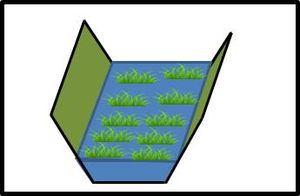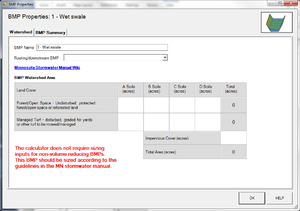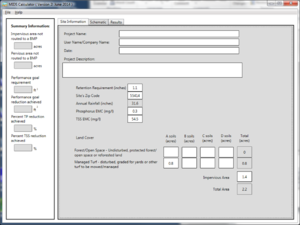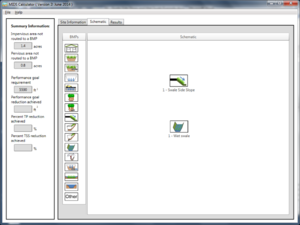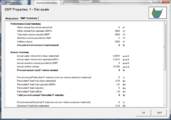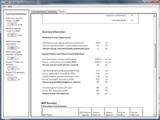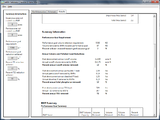
Difference between revisions of "Requirements, recommendations and information for using wet swale as a BMP in the MIDS calculator"
m |
Dfairbairn (talk | contribs) |
||
| Line 1: | Line 1: | ||
<noinclude>{{alert|This page will be under review during September 2014|alert-under-review}}</noinclude> | <noinclude>{{alert|This page will be under review during September 2014|alert-under-review}}</noinclude> | ||
| − | [[File:symbol for wet swale.jpg|300px|thumb|alt= | + | [[File:symbol for wet swale.jpg|300px|thumb|alt=Symbol used for Wet swale in the MIDS calculator.|<font size=3>Symbol used for Wet swale in the MIDS calculator.</font size>]] |
| − | + | A wet swale does not reduce stormwater volume. While this BMP does not provide stormwater volume reduction towards the instantaneous performance goal or on an annual basis, it does provide an annual pollutant load reduction for TSS. If runoff to the wet swale flows over a side slope through sheet flow, then a swale side slope BMP should be used in combination with the Wet swale BMP. | |
| − | A wet swale does not reduce stormwater volume. While this BMP does not provide stormwater volume reduction towards the performance goal or on an annual basis, it does provide annual pollutant load | ||
| − | [[File:Watershed tab for wet swale.png|300px|thumb|alt= | + | [[File:Watershed tab for wet swale.png|300px|thumb|alt=Screen shot of the Watershed tab for Wet swale|<font size=3>Screen shot of the Watershed tab for Wet swale. Note the warning that this BMP does not require sizing inputs. The BMP should be sized following guidelines in the Minnesota Stormwater Manual.</font size>]] |
====MIDS calculator user inputs for wet swale==== | ====MIDS calculator user inputs for wet swale==== | ||
| − | For the wet swale BMP, | + | For the wet swale BMP, the only design parameter that must be input by the user is BMP Watershed Area. |
*'''Watershed tab''' | *'''Watershed tab''' | ||
**'''BMP Name:''' this cell is auto-filled but can be changed by the user. | **'''BMP Name:''' this cell is auto-filled but can be changed by the user. | ||
| − | **'''Routing/downstream BMP:''' if this BMP is part of a [[Using the treatment train approach to BMP selection|treatment train]] and water is being routed from this BMP to another BMP, the user selects the name of the BMP | + | **'''Routing/downstream BMP:''' if this BMP is part of a [[Using the treatment train approach to BMP selection|treatment train]] and water is being routed from this BMP to another BMP, the user selects the name of the BMP to which water is being routed from the dropdown box. All water must be routed to a single downstream BMP. Note that the user must include the BMP receiving the routed water in the Schematic or the BMP will not appear in the dropdown box. |
| − | **'''BMP Watershed Area:''' | + | **'''BMP Watershed Area:''' BMP watershed areas are the areas draining directly to the BMP. Values can be added for four soil types ([[Glossary#H|Hydrologic Soil Groups]] (HSG) A, B, C, D) and for three Land Cover types (Forest/Open Space, Managed Turf, and Impervious Cover). The surface area of the BMP should be included as a managed turf land cover under the hydrologic soils group of the native soils located under the BMP. Units are in acres. |
| − | *'''BMP Summary Tab:''' The BMP Summary tab summarizes the volume and pollutant reductions provided by the specific BMP. It details the performance goal volume reductions and annual average volume, dissolved P, particulate P, and TSS load reductions. Included in the summary are the total volume and pollutant loads received by the BMP from its direct watershed, from upstream BMPs and a combined value of the two. Also included in the summary | + | *'''BMP Summary Tab:''' The BMP Summary tab summarizes the volume and pollutant reductions provided by the specific BMP. It details the performance goal volume reductions and annual average volume, dissolved P, particulate P, and TSS load reductions. Included in the summary are the total volume and pollutant loads received by the BMP from its direct watershed, from upstream BMPs, and a combined value of the two. Also included in the summary are the volume and pollutant load reductions provided by the BMP, along with the volume and pollutant loads that exit the BMP through the outflow. This outflow load and volume is what is routed to the downstream BMP, if one is defined in the Watershed tab. Finally, percent reductions are provided for the percent of the performance goal achieved, percent annual runoff volume retained, total percent annual particulate phosphorus reduction, total percent annual dissolved phosphorus reduction, total percent annual TP reduction, and total percent annual TSS reduction. Note that a Wet swale may achieve TSS removal, but no volume or phosphorus reduction is achieved by this type of BMP. |
==Methodology== | ==Methodology== | ||
| Line 22: | Line 21: | ||
“Required treatment volume,” or the volume of stormwater runoff delivered to the BMP, equals the performance goal (1.1 inches or user-specified performance goal) times the impervious area draining to the BMP. This stormwater is delivered to the BMP instantaneously following the [http://www.stormh2o.com/SW/Articles/Kerplunk_15253.aspx Kerplunk method]. | “Required treatment volume,” or the volume of stormwater runoff delivered to the BMP, equals the performance goal (1.1 inches or user-specified performance goal) times the impervious area draining to the BMP. This stormwater is delivered to the BMP instantaneously following the [http://www.stormh2o.com/SW/Articles/Kerplunk_15253.aspx Kerplunk method]. | ||
| + | Because a Wet swale does not reduce stormwater volume, there is no ''Required treatment volume'' associated with this BMP. | ||
===Volume Reduction=== | ===Volume Reduction=== | ||
| Line 27: | Line 27: | ||
===Pollutant Reduction=== | ===Pollutant Reduction=== | ||
| − | Pollutant load reductions are calculated on an annual basis. | + | Pollutant load reductions are calculated on an annual basis. Fixed removal rates of 68 percent TSS, 0 percent particulate phosphorus, and 0 percent dissolved phosphorus are applied to water that travels through the wet swale. |
NOTE: The user can modify event mean concentrations (EMCs) on the '''Site Information''' tab in the calculator. Default concentrations are 54.5 milligrams per liter for total suspended solids (TSS) and 0.3 milligrams per liter for total phosphorus (particulate plus dissolved). The calculator will notify the user if the default is changed. Changing the default EMC will result in changes to the total pounds of pollutant reduced. | NOTE: The user can modify event mean concentrations (EMCs) on the '''Site Information''' tab in the calculator. Default concentrations are 54.5 milligrams per liter for total suspended solids (TSS) and 0.3 milligrams per liter for total phosphorus (particulate plus dissolved). The calculator will notify the user if the default is changed. Changing the default EMC will result in changes to the total pounds of pollutant reduced. | ||
==Routing== | ==Routing== | ||
| − | A wet swale can be routed to any other BMP except for a green roof and a swale side slope or any BMP that would cause water to be rerouted back to the wet swale. | + | A wet swale can be routed to any other BMP except for a green roof and a swale side slope or any BMP that would cause water to be rerouted back to the wet swale. All BMPs can be routed to a wet swale. |
==Assumptions for wet swale== | ==Assumptions for wet swale== | ||
The following general assumption applies in calculating the credits for a wet swale. If this assumption is not followed the pollutant reduction credits cannot be applied. | The following general assumption applies in calculating the credits for a wet swale. If this assumption is not followed the pollutant reduction credits cannot be applied. | ||
| − | *The wet swale has been properly [[Design criteria for filtration|designed]], [[Construction specifications for filtration|constructed]] and will be properly [[Operation and maintenance of filtration|maintained]] according to specifications for filtration systems. | + | *The wet swale has been properly [[Design criteria for filtration|designed]], [[Construction specifications for filtration|constructed]], and will be properly [[Operation and maintenance of filtration|maintained]] according to specifications for filtration systems. |
| − | On the | + | On the Watershed tab for this BMP in the MIDS calculator, the following warning is given: “The calculator does not require sizing inputs for non-volume reducing BMPs. This BMP should be sized according to the guidelines in the Minnesota Stormwater Manual.” See [[Design criteria for filtration|design criteria]] and [[Construction specifications for filtration|construction specifications]]. |
==Swale Side Slope and Wet Swale Example== | ==Swale Side Slope and Wet Swale Example== | ||
[[File:Schematic for wet swale example.jpg|300px|left|thumb|alt=Schematic used to determine the watershed characteristics of your entire site|<font size=3>Schematic used to determine the watershed characteristics of your entire site, corresponding with Step 1 in the example. In this example, 1.4 acres of impervious drain to one of two side slopes and then into a wet swale. Total pervious acreage is the sum of the turf area, the two swale side slopes, and the wet swale, for a total pervious acreage of 0.8 acres.</font size>]] | [[File:Schematic for wet swale example.jpg|300px|left|thumb|alt=Schematic used to determine the watershed characteristics of your entire site|<font size=3>Schematic used to determine the watershed characteristics of your entire site, corresponding with Step 1 in the example. In this example, 1.4 acres of impervious drain to one of two side slopes and then into a wet swale. Total pervious acreage is the sum of the turf area, the two swale side slopes, and the wet swale, for a total pervious acreage of 0.8 acres.</font size>]] | ||
| − | [[File:Swale no underdrain site information tab.png|300px|thumb|alt= | + | [[File:Swale no underdrain site information tab.png|300px|thumb|alt=Screen shot of the Site Information tab of the MIDS calculator|<font size=3>Screen shot of the Site Information tab of the MIDS calculator. See Step 2.</font size>]] |
| − | [[File:Schematic tab wet swale example side slope.png|300px|thumb|alt= | + | [[File:Schematic tab wet swale example side slope.png|300px|thumb|alt=Screen shot of Schematic tab for wet swale example|<font size=3>Screen shot of Schematic tab for wet swale with a side slope. See Step 3.</font size>]] |
| − | The runoff from a 1.4 acre parking lot surrounded by 0.359 acre of pervious turf area flows through sheet flow over one of the side slopes of a swale and into the main channel of the swale, which consists of a wet swale. | + | The runoff from a 1.4 acre parking lot surrounded by 0.359 acre of pervious turf area flows through sheet flow over one of the side slopes of a swale and into the main channel of the swale, which consists of a wet swale. The soils across the area have a unified soils classification of SW (HSG type A soil). A second side slope associated with the wet swale does not receive runoff from impervious surfaces. Each of the swale side slopes are 800 feet long by 10 feet wide with a side slope of 5H:1V. The maintenance on the swale side slopes call for mowing once a year. The following steps detail how this system would be set up in the MIDS calculator. |
| − | '''Step 1''': Determine the watershed characteristics of your entire site. | + | '''Step 1''': Determine the watershed characteristics of your entire site. For this example we have a 2.2 acre site with 1.4 acres of impervious area (parking lot) and 0.8 acre of pervious area in type A soils. The pervious area includes the turf area and the area of the swale side slopes and main channel (wet swale). |
| − | '''Step 2''': Fill in the site specific information into the ''Site Information'' tab. | + | '''Step 2''': Fill in the site specific information into the ''Site Information'' tab. This includes entering a ZIP Code (55414 for this example) and the watershed information from Step 1. The Managed Turf area includes the turf area, the area of the side slopes, and the area of the main channel. ZIP code and impervious area must be filled in or an error message will be generated. Other fields on this screen are optional. |
| − | '''Step 3''': Go to the Schematic tab and drag and drop a ''Swale Side | + | '''Step 3''': Go to the Schematic tab and drag and drop a ''Swale Side Slope'' and a ''Wet Swale'' icon into the ''Schematic'' window |
| − | '''Step 4''': Determine the watershed characteristic for each of the BMP components. | + | '''Step 4''': Determine the watershed characteristic for each of the BMP components. For this example, the watershed of the swale side slope includes 1.4 acres of impervious area and 0.543 acre of pervious area (0.359 acre of turf area plus 0.184 acre of swale side slope). The watershed of the wet swale includes the pervious area of the wet swale (0.073 acre) and the pervious area of the other swale side slope (0.184 acre) for a total pervious area of 0.257 acre. Since no impervious area is being routed to the second side slope, the area can be included in the direct watershed area of the wet swale. However, the second swale side slope could be also placed in the calculator as a separate BMP. |
'''Step 5''': Open the BMP properties for the swale side slope by right clicking on the ''Swale Side Slope'' icon and selecting ''Edit BMP properties'', or by double clicking on the ''Swale Side Slope'' icon. | '''Step 5''': Open the BMP properties for the swale side slope by right clicking on the ''Swale Side Slope'' icon and selecting ''Edit BMP properties'', or by double clicking on the ''Swale Side Slope'' icon. | ||
| − | '''Step 6''': if help is needed, click on the ''Minnesota Stormwater Manual Wiki'' link or the ''Help'' button to review input parameter specifications and | + | '''Step 6''': if help is needed, click on the ''Minnesota Stormwater Manual Wiki'' link or the ''Help'' button to review input parameter specifications and calculations pertinent to the ''Swale Side Slope'' BMP. |
| − | '''Step 7''': Fill in the specific BMP watershed information (1.4 acres of impervious and 0.543 acre of Managed Turf on A Soils. | + | '''Step 7''': Fill in the specific BMP watershed information (1.4 acres of impervious and 0.543 acre of Managed Turf on A Soils. Route the swale side slope BMP to the wet swale BMP. |
| − | '''Step 8''': Enter | + | '''Step 8''': Enter the BMP design parameters into the ''BMP Parameters'' tab. This Swale Side Slope example would require the following entries: |
| − | *Side slope [H:V] | + | *Side slope [H:V]: 5:1 |
| − | *Flow path length | + | *Flow path length: 10 feet |
| − | *Channel length | + | *Channel length: 800 feet |
| − | *Underlying soil – Hydrologic Soil Group | + | *Underlying soil – Hydrologic Soil Group: 4 SW (HSG A, 1.63 in/hr) (selected in dropdown box) |
| − | *Manning’s n (vegetation) | + | *Manning’s n (vegetation): Native grass (selected in dropdown box) |
<gallery caption="MIDS calculator screen shots of data input screens. Click on an image for enlarged view." widths="140px"> | <gallery caption="MIDS calculator screen shots of data input screens. Click on an image for enlarged view." widths="140px"> | ||
| − | File:Watershed tab for wet swale example side slope.png|alt= | + | File:Watershed tab for wet swale example side slope.png|alt=Screen shot of Watershed tab for wet swale example side slope|Screen shot of Watershed tab for side slope and a wet swale. See Step 4. |
| − | File:BMP parameters tab 1 wet swale example side slope.png |alt= | + | File:BMP parameters tab 1 wet swale example side slope.png |alt=Screen shot of BMP Parameters tab inputs for the Swale Side Slope.|Screen shot of BMP Parameters tab inputs for Swale Side Slope. See Steps 5 through 8 in the example. |
| − | File:Watershed tab for wet swale example.png|alt= | + | File:Watershed tab for wet swale example.png|alt=Screen shot of Watershed tab for wet swale|Screen shot of Watershed tab for wet swale. See Step 13. |
</gallery> | </gallery> | ||
<gallery caption="MIDS calculator screen shots of results and summary tabs. Click on an image for enlarged view." widths="200px"> | <gallery caption="MIDS calculator screen shots of results and summary tabs. Click on an image for enlarged view." widths="200px"> | ||
| − | File:BMP Summary tab wet swale example 1.png|alt= | + | File:BMP Summary tab wet swale example 1.png|alt=Screen shot of BMP Summary tab for wet swale|Screen shot of BMP Summary tab for wet swale. See Step 14. |
| − | File:BMP Summary tab wet swale example 2.png|alt= | + | File:BMP Summary tab wet swale example 2.png|alt=Screen shot of Results tab for wet swale|Screen shot of Results tab for wet swale. See Step 16. |
| − | File:summary results tab for wet swale.png|alt= | + | File:summary results tab for wet swale.png|alt=Screen shot of Results tab for wet swale|Screen shot of Results tab for the wet swale with side slope example. See Step 16. |
</gallery> | </gallery> | ||
| Line 88: | Line 88: | ||
'''Step 10''': Click on the ''OK'' button to exit the BMP properties screen. An arrow will appear showing that the swale side slope has been routed to the wet swale. | '''Step 10''': Click on the ''OK'' button to exit the BMP properties screen. An arrow will appear showing that the swale side slope has been routed to the wet swale. | ||
| − | '''Step 11''': Open the BMP | + | '''Step 11''': Open the BMP Properties window for the swale main channel by right clicking on the ''Wet Swale'' icon and selecting ''Edit BMP properties'', or by double clicking on the ''Wet Swale'' icon. |
| − | '''Step 12''': Click on the ''Minnesota Stormwater Manual Wiki'' link or the ''Help'' button to review input parameter specifications and | + | '''Step 12''': Click on the ''Minnesota Stormwater Manual Wiki'' link or the ''Help'' button to review input parameter specifications and calculations specific to the ''Wet Swale.'' |
| − | '''Step 13''': Enter | + | '''Step 13''': Enter the watershed information for the Wet swale in the ''Watershed'' tab (0.257 acre for Pervious Turf on A Soil, which includes the area of the main channel and the other side slope). |
| − | '''Step 14''': Design parameters are not required for the wet swale BMP. | + | '''Step 14''': Design parameters are not required for the wet swale BMP. Click on ''BMP Summary'' tab to view results for this BMP. |
'''Step 15''': Click on the ''OK'' button to exit the BMP properties screen. | '''Step 15''': Click on the ''OK'' button to exit the BMP properties screen. | ||
Revision as of 21:38, 3 October 2014
This page will be under review during September 2014
A wet swale does not reduce stormwater volume. While this BMP does not provide stormwater volume reduction towards the instantaneous performance goal or on an annual basis, it does provide an annual pollutant load reduction for TSS. If runoff to the wet swale flows over a side slope through sheet flow, then a swale side slope BMP should be used in combination with the Wet swale BMP.
Contents
MIDS calculator user inputs for wet swale
For the wet swale BMP, the only design parameter that must be input by the user is BMP Watershed Area.
- Watershed tab
- BMP Name: this cell is auto-filled but can be changed by the user.
- Routing/downstream BMP: if this BMP is part of a treatment train and water is being routed from this BMP to another BMP, the user selects the name of the BMP to which water is being routed from the dropdown box. All water must be routed to a single downstream BMP. Note that the user must include the BMP receiving the routed water in the Schematic or the BMP will not appear in the dropdown box.
- BMP Watershed Area: BMP watershed areas are the areas draining directly to the BMP. Values can be added for four soil types (Hydrologic Soil Groups (HSG) A, B, C, D) and for three Land Cover types (Forest/Open Space, Managed Turf, and Impervious Cover). The surface area of the BMP should be included as a managed turf land cover under the hydrologic soils group of the native soils located under the BMP. Units are in acres.
- BMP Summary Tab: The BMP Summary tab summarizes the volume and pollutant reductions provided by the specific BMP. It details the performance goal volume reductions and annual average volume, dissolved P, particulate P, and TSS load reductions. Included in the summary are the total volume and pollutant loads received by the BMP from its direct watershed, from upstream BMPs, and a combined value of the two. Also included in the summary are the volume and pollutant load reductions provided by the BMP, along with the volume and pollutant loads that exit the BMP through the outflow. This outflow load and volume is what is routed to the downstream BMP, if one is defined in the Watershed tab. Finally, percent reductions are provided for the percent of the performance goal achieved, percent annual runoff volume retained, total percent annual particulate phosphorus reduction, total percent annual dissolved phosphorus reduction, total percent annual TP reduction, and total percent annual TSS reduction. Note that a Wet swale may achieve TSS removal, but no volume or phosphorus reduction is achieved by this type of BMP.
Methodology
Required Treatment Volume
“Required treatment volume,” or the volume of stormwater runoff delivered to the BMP, equals the performance goal (1.1 inches or user-specified performance goal) times the impervious area draining to the BMP. This stormwater is delivered to the BMP instantaneously following the Kerplunk method.
Because a Wet swale does not reduce stormwater volume, there is no Required treatment volume associated with this BMP.
Volume Reduction
This BMP does not provide volume reduction towards the performance goal.
Pollutant Reduction
Pollutant load reductions are calculated on an annual basis. Fixed removal rates of 68 percent TSS, 0 percent particulate phosphorus, and 0 percent dissolved phosphorus are applied to water that travels through the wet swale.
NOTE: The user can modify event mean concentrations (EMCs) on the Site Information tab in the calculator. Default concentrations are 54.5 milligrams per liter for total suspended solids (TSS) and 0.3 milligrams per liter for total phosphorus (particulate plus dissolved). The calculator will notify the user if the default is changed. Changing the default EMC will result in changes to the total pounds of pollutant reduced.
Routing
A wet swale can be routed to any other BMP except for a green roof and a swale side slope or any BMP that would cause water to be rerouted back to the wet swale. All BMPs can be routed to a wet swale.
Assumptions for wet swale
The following general assumption applies in calculating the credits for a wet swale. If this assumption is not followed the pollutant reduction credits cannot be applied.
- The wet swale has been properly designed, constructed, and will be properly maintained according to specifications for filtration systems.
On the Watershed tab for this BMP in the MIDS calculator, the following warning is given: “The calculator does not require sizing inputs for non-volume reducing BMPs. This BMP should be sized according to the guidelines in the Minnesota Stormwater Manual.” See design criteria and construction specifications.
Swale Side Slope and Wet Swale Example
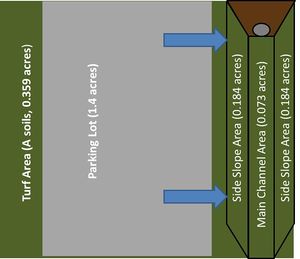
The runoff from a 1.4 acre parking lot surrounded by 0.359 acre of pervious turf area flows through sheet flow over one of the side slopes of a swale and into the main channel of the swale, which consists of a wet swale. The soils across the area have a unified soils classification of SW (HSG type A soil). A second side slope associated with the wet swale does not receive runoff from impervious surfaces. Each of the swale side slopes are 800 feet long by 10 feet wide with a side slope of 5H:1V. The maintenance on the swale side slopes call for mowing once a year. The following steps detail how this system would be set up in the MIDS calculator.
Step 1: Determine the watershed characteristics of your entire site. For this example we have a 2.2 acre site with 1.4 acres of impervious area (parking lot) and 0.8 acre of pervious area in type A soils. The pervious area includes the turf area and the area of the swale side slopes and main channel (wet swale).
Step 2: Fill in the site specific information into the Site Information tab. This includes entering a ZIP Code (55414 for this example) and the watershed information from Step 1. The Managed Turf area includes the turf area, the area of the side slopes, and the area of the main channel. ZIP code and impervious area must be filled in or an error message will be generated. Other fields on this screen are optional.
Step 3: Go to the Schematic tab and drag and drop a Swale Side Slope and a Wet Swale icon into the Schematic window
Step 4: Determine the watershed characteristic for each of the BMP components. For this example, the watershed of the swale side slope includes 1.4 acres of impervious area and 0.543 acre of pervious area (0.359 acre of turf area plus 0.184 acre of swale side slope). The watershed of the wet swale includes the pervious area of the wet swale (0.073 acre) and the pervious area of the other swale side slope (0.184 acre) for a total pervious area of 0.257 acre. Since no impervious area is being routed to the second side slope, the area can be included in the direct watershed area of the wet swale. However, the second swale side slope could be also placed in the calculator as a separate BMP.
Step 5: Open the BMP properties for the swale side slope by right clicking on the Swale Side Slope icon and selecting Edit BMP properties, or by double clicking on the Swale Side Slope icon.
Step 6: if help is needed, click on the Minnesota Stormwater Manual Wiki link or the Help button to review input parameter specifications and calculations pertinent to the Swale Side Slope BMP.
Step 7: Fill in the specific BMP watershed information (1.4 acres of impervious and 0.543 acre of Managed Turf on A Soils. Route the swale side slope BMP to the wet swale BMP.
Step 8: Enter the BMP design parameters into the BMP Parameters tab. This Swale Side Slope example would require the following entries:
- Side slope [H:V]: 5:1
- Flow path length: 10 feet
- Channel length: 800 feet
- Underlying soil – Hydrologic Soil Group: 4 SW (HSG A, 1.63 in/hr) (selected in dropdown box)
- Manning’s n (vegetation): Native grass (selected in dropdown box)
- MIDS calculator screen shots of data input screens. Click on an image for enlarged view.
- MIDS calculator screen shots of results and summary tabs. Click on an image for enlarged view.
Step 9: Click on BMP Summary tab to view results for this BMP.
Step 10: Click on the OK button to exit the BMP properties screen. An arrow will appear showing that the swale side slope has been routed to the wet swale.
Step 11: Open the BMP Properties window for the swale main channel by right clicking on the Wet Swale icon and selecting Edit BMP properties, or by double clicking on the Wet Swale icon.
Step 12: Click on the Minnesota Stormwater Manual Wiki link or the Help button to review input parameter specifications and calculations specific to the Wet Swale.
Step 13: Enter the watershed information for the Wet swale in the Watershed tab (0.257 acre for Pervious Turf on A Soil, which includes the area of the main channel and the other side slope).
Step 14: Design parameters are not required for the wet swale BMP. Click on BMP Summary tab to view results for this BMP.
Step 15: Click on the OK button to exit the BMP properties screen.
Step 16: Click on Results tab to see overall results for the site.
Information
- Construction specifications for filtration BMPs
- Information on operation and maintenance of filtration BMPs.
Links to MIDS pages
- Overview of Minimal Impact Design Standards (MIDS)
- Performance goals for new development, re-development and linear projects
- Design Sequence Flowchart-Flexible treatment options
- Community Assistance Package
- MIDS calculator
- Performance curves for MIDS calculator
- Training and workshop materials and modules
- Technical documents
